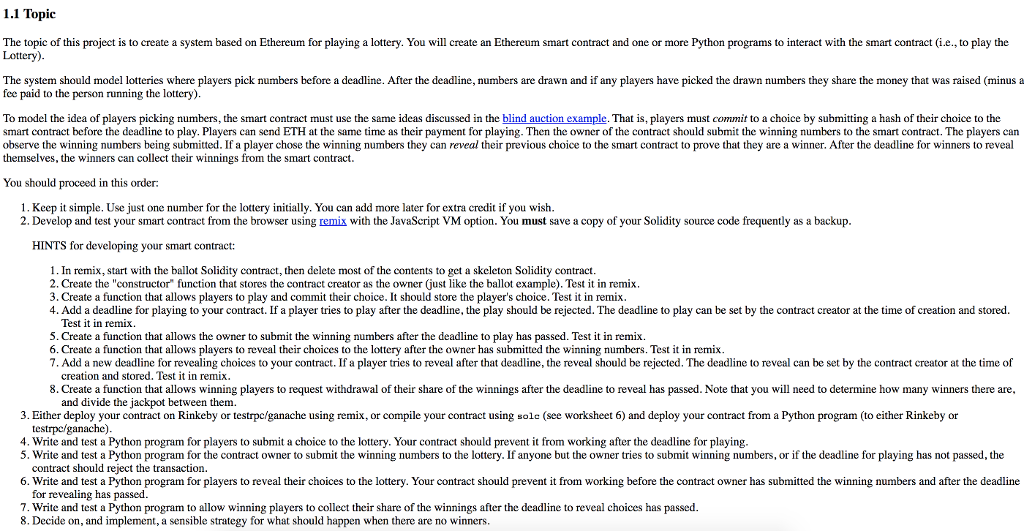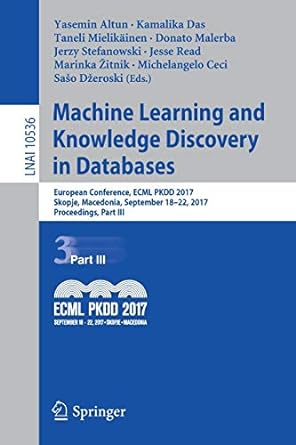
1.1 Topic The topic of this project is to create a system based on Ethereum for playing a lottery. You will create an Ethereum smart contract and one or more Python programs to interact with the smart contract (i.e., to play the Lottery The system should model lotteries where players pick numbers before a deadline. After the deadline, numbers are drawn and if any players have picked the drawn numbers they share the money that was raised (minus fee paid to the person running the lottery). To model the idea of players picking numbers, the smart contract must use the same ideas discussed in the blind auction example. That is, players must commit to a choice by submitting a hash of their choice to the smart contract before the deadline to play. Players can send ETH at the same time as their payment for playing. Then the owner of the contract should submit the winning numbers to the smart contract. The players can observe the winning numbers being submitted. If a player chose the winning numbers they can reveal their previous choice to the smart contract to prove that they are a winner. After the deadline for winners to reveal themselves, the winners can collect their winnings from the smart contract. You should proceed in this order: 1. Keep it simple. Use just one number for the lottery initially. You can add more later for extra credit if you wish 2. Develop and test your smart contract from the browser using remix with the JavaScript VM option. You must save a copy of your Solidity source code frequently as a backup HINTS for developing your smart contract: 1. In remix, start with the ballot Solidity contract, then delete most of the contents to get a skeleton Solidity contract 2. Create the "constructor" function that stores the contract creator as the owner (Gust like the ballot example). Test it in remix 3. Create a function that allows players to play and commit their choice. It should store the player's choice. Test it in remix 4. Add a deadline for playing to your contract. If a player tries to play after the deadline, the play should be rejected. The deadline to play can be set by the contract creator at the time of creation and stored. Test it in remix 5. Create a function that allows the owner to submit the winning numbers after the deadline to play has passed. Test it in remix 6. Create a function that allows players to reveal their choices to the lottery after the owner has submitted the winning numbers. Test it in remix 7. Add a new deadline for revealing choices to your contract. If a player tries to reveal after that deadline, the reveal should be rejected. The deadline to reveal can be set by the contract creator at the time of creation and stored. Test it in remix 8. Create a function that allows winning players to request withdrawal of their share of the winnings after the deadline to reveal has passed. Note that you will need to determine how many winners there are, and divide the jackpot between them 3. Either deploy your contract on Rinkeby or testrpc/ganache using remix, or compile your contract using sole (see worksheet 6) and deploy your contract from a Python program (to either Rinkeby or testrpc/ganachc) 4. Write and test a Python program for players to submit a choice to the lottery. Your contract should prevent it from working after the deadline for playing 5. Write and test a Python program for the contract owner to submit the winning numbers to the lottery. If anyone but the owner tries to submit winning numbers, or if the deadline for playing has not passed, the contract should reject the transaction. 6. Write and test a Python program for players to reveal their choices to the lottery. Your contract should prevent it from working before the contract owner has submitted the winning numbers and after the deadline for revealing has passed. 7. Write and test a Python program to allow winning players to collect their share of the winnings after the deadline to reveal choices has passed. 8. Decide on, and implement, a sensible strategy for what should happen when there are no winners. 1.1 Topic The topic of this project is to create a system based on Ethereum for playing a lottery. You will create an Ethereum smart contract and one or more Python programs to interact with the smart contract (i.e., to play the Lottery The system should model lotteries where players pick numbers before a deadline. After the deadline, numbers are drawn and if any players have picked the drawn numbers they share the money that was raised (minus fee paid to the person running the lottery). To model the idea of players picking numbers, the smart contract must use the same ideas discussed in the blind auction example. That is, players must commit to a choice by submitting a hash of their choice to the smart contract before the deadline to play. Players can send ETH at the same time as their payment for playing. Then the owner of the contract should submit the winning numbers to the smart contract. The players can observe the winning numbers being submitted. If a player chose the winning numbers they can reveal their previous choice to the smart contract to prove that they are a winner. After the deadline for winners to reveal themselves, the winners can collect their winnings from the smart contract. You should proceed in this order: 1. Keep it simple. Use just one number for the lottery initially. You can add more later for extra credit if you wish 2. Develop and test your smart contract from the browser using remix with the JavaScript VM option. You must save a copy of your Solidity source code frequently as a backup HINTS for developing your smart contract: 1. In remix, start with the ballot Solidity contract, then delete most of the contents to get a skeleton Solidity contract 2. Create the "constructor" function that stores the contract creator as the owner (Gust like the ballot example). Test it in remix 3. Create a function that allows players to play and commit their choice. It should store the player's choice. Test it in remix 4. Add a deadline for playing to your contract. If a player tries to play after the deadline, the play should be rejected. The deadline to play can be set by the contract creator at the time of creation and stored. Test it in remix 5. Create a function that allows the owner to submit the winning numbers after the deadline to play has passed. Test it in remix 6. Create a function that allows players to reveal their choices to the lottery after the owner has submitted the winning numbers. Test it in remix 7. Add a new deadline for revealing choices to your contract. If a player tries to reveal after that deadline, the reveal should be rejected. The deadline to reveal can be set by the contract creator at the time of creation and stored. Test it in remix 8. Create a function that allows winning players to request withdrawal of their share of the winnings after the deadline to reveal has passed. Note that you will need to determine how many winners there are, and divide the jackpot between them 3. Either deploy your contract on Rinkeby or testrpc/ganache using remix, or compile your contract using sole (see worksheet 6) and deploy your contract from a Python program (to either Rinkeby or testrpc/ganachc) 4. Write and test a Python program for players to submit a choice to the lottery. Your contract should prevent it from working after the deadline for playing 5. Write and test a Python program for the contract owner to submit the winning numbers to the lottery. If anyone but the owner tries to submit winning numbers, or if the deadline for playing has not passed, the contract should reject the transaction. 6. Write and test a Python program for players to reveal their choices to the lottery. Your contract should prevent it from working before the contract owner has submitted the winning numbers and after the deadline for revealing has passed. 7. Write and test a Python program to allow winning players to collect their share of the winnings after the deadline to reveal choices has passed. 8. Decide on, and implement, a sensible strategy for what should happen when there are no winners







